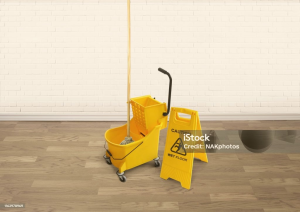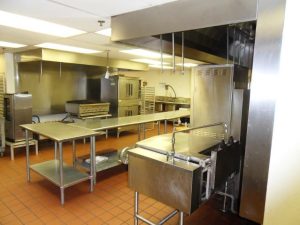65 10.4: Storage & Cleaning Schedules
Storage
Once dry, clean and sanitized items should be
- stored in a clean dry location not exposed to splash, dust or other contamination
- at least 6 inches off the floor
- covered or inverted to prevent contamination
 Cleaning tools need to be provided to ensure proper sanitation of the facility. A separate set of cleaning tools should be allocated for the restrooms and the kitchen. These tools should be in proper working condition, cleaned regularly and stored to prevent mildew and mold.
Cleaning tools need to be provided to ensure proper sanitation of the facility. A separate set of cleaning tools should be allocated for the restrooms and the kitchen. These tools should be in proper working condition, cleaned regularly and stored to prevent mildew and mold.
Mops, dustpans, brushes and brooms should be hanging and mop water emptied when not in use. Mop water should be disposed of in a service sink and not toilets. Sponges are allowed during cleaning but should not be used during the rinsing or sanitizing steps. Because of the composition of a sponge, harmful pathogens can grow inside the sponge and spread to sanitized surfaces.
Food spills, counters and equipment can be wiped with a cloth. Wet clothes, when not being used, should be stored in a chemical sanitizing solution. Soiled linens should be stored in a clean, washable laundry bag or receptacle. Linens and clothes can be laundered on or off site.
Water that is safe to consume is referred to as potable water. Potable water should be used in the cleaning process to ensure equipment is not contaminated. Sources of potable water include public water mains, well water, and bottled or packaged water. Sufficient quantities, temperature and pressure of the potable water is required to meet the needs of the facility.
 Cleaning schedules are designed to maintain a clean and healthy atmosphere and eliminate contamination. There are two types of cleaning schedules, daily and heavy-duty schedules. Each of these schedules communicate what, when, who and how a cleaning task should be performed. The list of daily cleaning duties identifying everyday tasks should be developed by managers and enforced. This daily cleaning list includes tasks such as taking out the garage to the dumpster, sweeping and mopping floors, breaking down the dish machine, cleaning and sanitizing sinks. In addition to a daily cleaning list, a heavy-duty cleaning schedule can be developed to maintain a clean environment. These heavy-duty cleaning tasks are not required to be performed daily but rather on a regularly scheduled basis: weekly, biweekly, or monthly. Examples of duties on this list include cleaning hood vents, wiping down walls, cleaning the interior and exterior of refrigerators, freezers and ovens.
Cleaning schedules are designed to maintain a clean and healthy atmosphere and eliminate contamination. There are two types of cleaning schedules, daily and heavy-duty schedules. Each of these schedules communicate what, when, who and how a cleaning task should be performed. The list of daily cleaning duties identifying everyday tasks should be developed by managers and enforced. This daily cleaning list includes tasks such as taking out the garage to the dumpster, sweeping and mopping floors, breaking down the dish machine, cleaning and sanitizing sinks. In addition to a daily cleaning list, a heavy-duty cleaning schedule can be developed to maintain a clean environment. These heavy-duty cleaning tasks are not required to be performed daily but rather on a regularly scheduled basis: weekly, biweekly, or monthly. Examples of duties on this list include cleaning hood vents, wiping down walls, cleaning the interior and exterior of refrigerators, freezers and ovens.
 Standard operating procedures should be developed for cleaning up hazardous situations such as vomit, diarrhea or other bodily fluids. Employees should be provided with personal protective equipment to protect themselves from contact with such hazardous substances.
Standard operating procedures should be developed for cleaning up hazardous situations such as vomit, diarrhea or other bodily fluids. Employees should be provided with personal protective equipment to protect themselves from contact with such hazardous substances.
water having bacteriological, physical, radiological and chemical qualities that make it safe and suitable for human consumption
